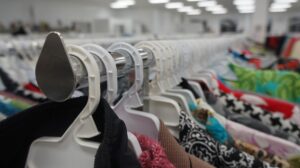In the fashion industry, there is a high demand for new styles and trends. But after every season, millions of garments are thrown away as they are no longer wanted. What's worse is that many of these discarded clothing items still have value and can be donated or sold to thrift stores. By reusing unwanted clothes, we could reduce the total amount of waste produced by the fashion industry each year.
What Harmful Waste the Fashion Industry Produces
One of the most polluting sectors on the planet is the fashion industry. In fact, it's responsible for as much waste as any other industry on the planet. Let's break it down:
– The fashion industry generates an amount of waste that's nearly the same size as New York City every year.
– Every person alive on Earth wears roughly 68 pounds of clothes per year (according to the EPA).
– The average woman owns about 23 pairs of shoes and 12 purses.
All this adds up to about 20 billion pounds of waste annually. With no signs of slowing down, it's time to make a change. One way is by donating your gently used clothing and accessories to charity.
Reusing Clothes (Thrift Shops)
Clothes are one of the most wasteful items in our society, with an estimated 70 billion pieces of clothing sent to landfills each year. One way to reduce this waste is by reusing clothes from thrift stores and donating them. And these days, you don't have to leave your home to look for these stores since there are great thrift shops online that offer a great selection of second-hand clothes. About 10% of clothes donated to thrift shops are sold to customers. When clothes are reused, it saves about 80% of the water and energy required to make them.
- Clothing that is recycled instead of thrown away will use 68% fewer fossil fuels, 49% less water, and release 50% less CO2.
- Every year, the average American discards around 80 pounds of apparel. That would be enough to fill a garbage truck!
- A person can save up to $300 a year by reusing clothes from thrift stores instead of buying new ones.

Using Sustainable Materials
The fashion industry is the second most polluting industry in the world, and textile waste is a large contributor to this. One-third of all clothes purchased end up in a landfill, and the average person throws away 65 pounds of clothing every year.
As consumers become more environmentally conscious, they are demanding clothing that is made from sustainable materials and produced responsibly.
It is also a very promising market for investors. As of 2017, there were over 1,000 fashion startups with a combined valuation of $4 billion.
The latest project to come out of this industry is Stella Valle, which produces high-quality lingerie from used coffee grounds. The company was founded by Laura Slatkin and Kevin Jones in 2017 after they met at an event about sustainability in New York City. The underwear is made from 100 percent recycled coffee grounds, and the company claims that it will never lose its shape or shrink. The product has been compared to Lululemon's $98 yoga pants, which were also created with technical fabrics and a high price point.
The Stella Valle underwear is being sold at a steep price: $38 for one pair of undies.
Using Less Water & Energy in the Production Process
Water, energy, and chemicals are used to create clothing but most times these resources are wasted in the process. This is a common issue for companies that want to proactively reduce their environmental impact.
The clothes production process is a large contributor to toxic waste. With highly innovative technologies and new strategies, companies can produce more with less water, energy, and chemicals.
One company that is demonstrating this approach is Icebreaker. Originally, they created garments from synthetic fibers made from petroleum and other chemical compounds that were destroying our environment, but they have since developed a new way to make their clothes without any harmful waste, pollution, or carbon emissions. Their new garments are made from Merino wool, which is a natural product that comes from sheep and does not require the use of chemicals or waste products.
In the past few years, there has been an increased awareness of harmful chemicals being released into the environment. This blog post discussed several ways that we can reduce our harm to the environment and make a positive impact on future generations by simply taking a few steps towards sustainability when purchasing clothing.

